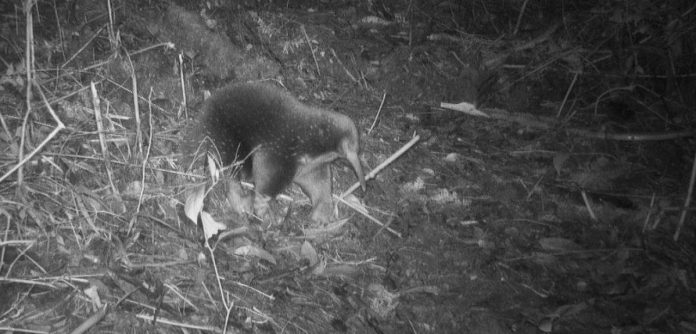More than sixty years after it was last recorded, an expedition team has rediscovered an iconic, egg-laying mammal in one of the most unexplored regions of the world. Attenborough’s long-beaked echidna, named after famed broadcaster Sir David Attenborough, was captured for the first time in photos and video footage using remote trail cameras set up in the Cyclops Mountains of Indonesia’s Papua Province.
Recorded by science only once in 1961, Attenborough’s long-beaked echidna is a monotreme: an evolutionarily distinct group of egg-laying mammals that includes the platypus. This echidna species is so special because it is one of only five remaining species of monotremes, the sole guardians of this remarkable branch of the tree of life. Echidnas are notoriously difficult to find since they are nocturnal, live in burrows, and tend to be very shy. Attenborough’s long-beaked echidna has never been recorded anywhere outside the Cyclops Mountains, and is currently classified as Critically Endangered on the IUCN Red List of Threatened Species
To give themselves the best chance of finding one, the team deployed over 80 trail cameras, making multiple ascents of the mountains, and climbing more than 11,000 meters (more than the height of Everest) in the process. For almost the entire four weeks that the team spent in the forest, the cameras recorded no sign of the echidna. On the last day, with the last images on the final memory card, the team obtained their shots of the elusive mammal – the first ever photographs of Attenborough’s echidna. The identification of the species was later confirmed by Professor Kristofer Helgen, mammalogist and chief scientist and director of the Australian Museum Research Institute (AMRI).
Dr James Kempton (Department of Biology, University of Oxford), said: ‘The discovery is the result of a lot of hard work and over three and a half years of planning. A key reason why we succeeded is because, with the help of YAPPENDA, we have spent years building a relationship with the community of Yongsu Sapari, a village on the north coast of the Cyclops Mountains. The trust between us was the bedrock of our success because they shared with us the knowledge to navigate these treacherous mountains, and even allowed us to research on lands that have never before felt the tread of human feet.’
Rediscovering the echidna is only the beginning of the expedition’s mission. Attenborough’s long-beaked echidna is the flagship animal of the Cyclops Mountains and a symbol of its extraordinary biodiversity. The team hope that its rediscovery will help bring attention to the conservation needs of the Cyclops, and Indonesian New Guinea more generally, and they are committed to supporting long-term monitoring of the echidna. Key to this work is NGO YAPPENDA, whose mission is to protect the natural environment of Indonesian New Guinea through empowerment of Indigenous Papuans. As part of the expedition team, members of YAPPENDA helped train six students from UNCEN in biodiversity surveys and camera trapping during the expedition.
With the team having only sorted a fraction of the material collected on the expedition, they expect that the coming months will yield even more new species. The intention is to name many of these after the Papuan members of the expedition.







